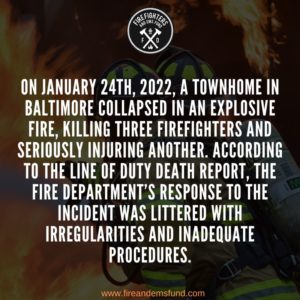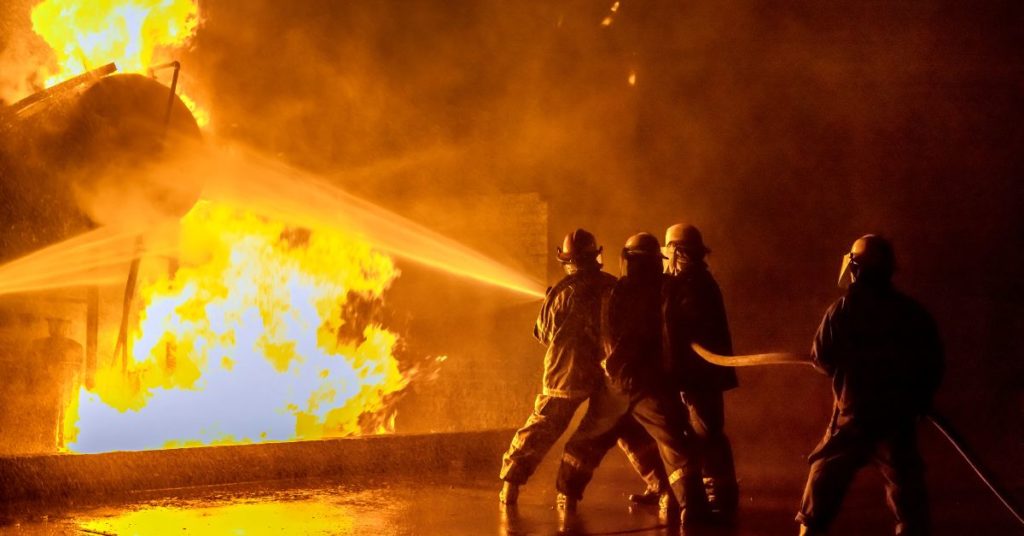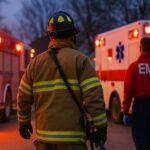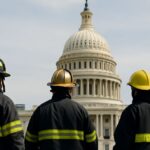On January 24th, 2022, an abandoned townhome in Baltimore collapsed due to an explosive fire, killing three firefighters and seriously injuring a fourth. For the Baltimore City Fire Department, this was the deadliest duty they’d faced since 1955.
Such an abnormal death toll could not pass without an investigation. As a result, on September 13th, 2022, the Baltimore City Fire Service published the findings of its Line of Duty Death Investigation inquiry. The mistakes and disorganization highlighted in this report forced the city’s Fire Chief to resign immediately.
What Happened That Day?
On that fateful day, Baltimore firefighters were alerted about a large fire in downtown Baltimore before dawn. Initial reports suggested that children may have been in the building, even though it was an abandoned townhouse.
As a result, the first team was dispatched at 05:53 AM. A few minutes later, the building’s interior collapsed, trapping four firefighters. Out of them, Lieutenant Paul Butrim, Lieutenant Kelsey Sadler, and EMT Kenny Lacayo all died. EMT John McMaster was also trapped in the collapse but was promptly rescued and survived his injuries.
Attempts to rescue the other three officers lasted between 90 minutes and 10 hours – a crucial delay.
How Did This Happen? The LODD Tells Us
According to the Line of Duty Death report, the Fire Department’s response to the incident was littered with irregularities and inadequate procedures. These can be classified into three different categories:
1. Unsuitable or insufficient equipment
Upon arrival at the scene, Baltimore’s firefighters didn’t have access to technology, equipment, and procedures that would have preserved their lives.

Most notably, two of the trapped firefighters didn’t have a radio on them. In addition, their mobile data terminal ran out of battery shortly after it was taken away from the vehicle.
Other important shortcomings included:
- The possible lack of RIT bags, which was reported by the squad’s survivors
- They had no battery-powered tools at hand after the gas-powered ones stalled
- There were no compatible fittings available for the department’s high-capacity air-charging apparatus
- The truck’s extended ladder could not support the basket used to lift firefighters back to safety
2. Overstrained forces
The responding squad was short-staffed from the very beginning, which hindered their ability to coordinate and adapt to the changing circumstances. According to the report, two squad members had noticed the impending collapse and approached the commander about it. However, the latter had no time to call for an evacuation before the collapse occurred.
Shortly after, the team outside the building could not secure an exclusive radio channel related to the Mayday. Rescue efforts had to be coordinated amidst 185 non-emergency messages, which added to the chaos.
3. Poor procedures
Several routine protocols were not respected during the incident’s response. No tactical worksheet was drafted outlining unit assignments or keeping track of the force’s headcount. There was no pre-designated staging area. No Personnel Accountability Report (PAR) was done until 40 minutes after the collapse – which means that, during this time, the incident commander did not know how many officers were trapped or at risk.
Will the Next Steps Save Future Firefighters?
Many of the issues highlighted in the report speak of systemic problems that had become part of the regular modus operandi at Baltimore’s Fire Department. This likely prompted the Fire Chief’s immediate resignation. For the families of Baltimore’s firefighters – including those who still mourn Butrim, Sadler, and Lacayo – this will only bring consolation as long as it signals improved working conditions. Just like the humanitarian example set by these officers, the lessons contained in this report should be remembered.









